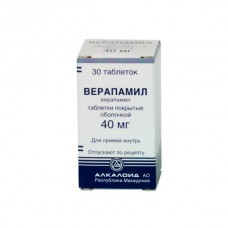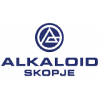Expiration date: 03/2026
The composition and form of issue:
Tablets, film-coated 1 tablet contains:
verapamil hydrochloride 0.04 g or 0.08 g
excipients: calcium phosphate disodium butylhydroxyanisole starch purified talc magnesium stearate gelatin methylparaben hydroxypropyl methylcellulose titanium dioxide talc-purified Indigo Carmine
in a contour acheikova packing 10, 15 or 25 PCs. in cardboard pack 1, 2, 3, 4, 5, and 10 pieces or in banks, PE for 30, 50 or 100 pieces in the paper cartons 1 Bank.
Feature:
Verapamil is one of the main drugs of the group of CCL.
Pharmacokinetics:
When you receive inside absorbed more than 90% of the dose. Metabolizmu with "first pass" through the liver. Protein binding 90%. T1/2 when receiving single doses is 2.8–7.4 hours when receiving repeated doses of 4.5–12 hours write mainly kidneys and 9-16% through the intestine. The main metabolite is norverapamil, which has less pronounced hypotensive activity than the unmodified verapamil.
Description pharmacological action:
The drug reduces the need of myocardium in oxygen by reducing contractility of the myocardium and decrease heart rate. Causes dilation of the coronary vessels and increases coronary blood flow reduces the tone of smooth muscles of peripheral arteries and peripheral vascular resistance.
Verapamil slows AV conduction, suppresses automaticity sinusnogo hub, which allows you to use the drug for the treatment of supraventricular arrhythmias.
Verapamil is the drug of choice for treatment of angina vasospastic origin (angina Prinzmetala). Effect in angina and in the treatment of angina with supraventricular arrhythmias.
Indications:
- treatment and prevention of cardiac arrhythmias: paroxysmal supraventricular tachycardia, atrial flutter and atrial fibrillation (tahiaritmicheskoy), supraventricular extrasystoles
- treatment and prevention of angina pectoris: chronic stable angina (exertional angina), unstable angina (angina at rest), vasospastic angina (Prinzmetal's angina, variant angina)
- the treatment of hypertension.
Contraindications:
- hypersensitivity to the drug
- bradycardia
- chronic heart failure IIB–III stage
- cardiogenic shock (except arrhythmia induced)
- sinoatrial block
- AV blockade II and III degree (except in patients with artificial driver rhythm)
- syndrome weakness sinusnogo hub
- the syndrome of Wolff-Parkinson-white
- syndrome of Morgagni-Adams-Stokes
- acute heart failure
- simultaneous application beta-blockers
- children up to age 18 years.
Application of pregnancy and breast-feeding:
The use of verapamil during pregnancy is possible only in the case when expected benefit for mother exceeds the potential risk to the fetus.
If necessary, use of the drug during lactation should be aware that verapamil is excreted in breast milk, therefore breastfeeding should be discontinued.
Side effects:
When using Verapamil possible:
From the side of cardiovascular system: facial flushing, bradycardia, AV blockade, hypotension, symptoms of heart failure when using the drug in high doses, especially in predisposed patients.
Gastrointestinal: nausea, vomiting, constipation and in some cases — a transient increase in liver transaminases in the blood plasma
CNS: dizziness, headache, rarely — increased nervous irritability, lethargy, fatigue.
Allergic reactions: skin rash, itching.
Other: the development of peripheral edema.
Drug interactions:
With simultaneous use of Verapamil:
- with anti-arrhythmic means, beta-blockers and inhaled anesthetics has been increasing cardiodepressivne effect (increase risk of AV blockade, a sharp decline in heart rate, heart failure, plummeting blood pressure)
- with antihypertensive drugs and diuretics — may increase hypotensive effect of verapamil
- digoxin — may increase the concentration of digoxin in plasma in connection with the deterioration of its excretion by the kidneys (so you need to check the level of digoxin in the blood plasma to identify optimal dosages and to prevent toxicity)
- with cimetidine and ranitidine increases the concentration of verapamil in plasma
- with rifampicin, phenobarbital — may decrease the concentration in plasma, reduce the action of verapamil
- theophylline, prazosinem, with cyclosporine — may increase the concentration of these substances in blood plasma
- with muscle relaxants — muscle relaxant may increase the actions
- with acetylsalicylic acid increases the risk of bleeding
- with quinidine increases the concentration of quinidine in plasma, increased threat of blood pressure reduction, and patients
- with hypertrophic cardiomyopathy may cause severe hypotension
- with carbamazepine and lithium increases the risk of neurotoxic effects.
Method of application and dose:
Inside, during or after delivery, squeezed small amounts of water.
The dosage regimen and duration of treatment set individually depending on the patient's condition, severity, characteristics of the disease and effectiveness of therapy.
For the prevention of angina attacks, arrhythmias and in the treatment of hypertension drug prescribed to adults in the initial dose of 40-80 mg 3-4 times a day. If necessary, increase the dose to 120 to 160 mg.
The maximum daily dose was 480 mg.
In patients with severe impaired liver function the excretion of Verapamil from the body slowly, so treatment should begin with minimal doses. Daily dose should not exceed 120 mg.
Overdose:
Symptoms: large doses (up to 6 g) can cause profound depression of consciousness, hypotension, sinus bradycardia followed by AV blockade, sometimes — asystole..
Treatment: in the event of hypotension and/or complete AV blockade — in/in the introduction of fluids, dopamine (dopamine), calcium gluconate, isoproterenol or norepinephrine. Treatment is symptomatic and depends on the clinical picture of overdose. Hemodialysis is not effective.
Special instructions:
With caution should appoint drug in patients with AV blockade of I degree, chronic heart failure I and II degree, arterial hypotension (SBP <100 mm Hg. Hg), bradycardia, severe disorders of liver function.
When treatment is necessary to control the functions of the cardiovascular and respiratory systems, blood sugar and electrolytes in the blood, BCC and the amount of urine passed.



